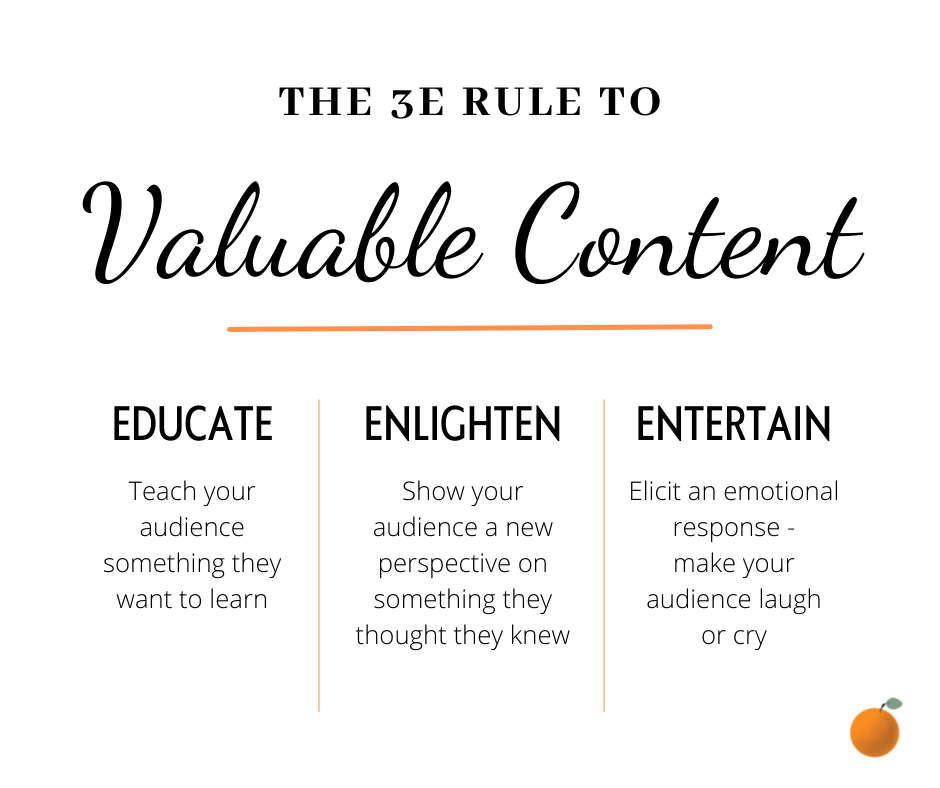When you begin your content marketing journey, one phrase comes up again and again – “bring value.” The gurus make it sound easy. “Just bring value to your audience!” they chirp.
OK, sounds good. Just one question. What the heck does that mean?
One way to create valuable content is by building pieces that follow the 3E Rule.
The 3E Rule for Valuable Content
The 3E rule lays out three ways you can package your content so your audience takes something away from it. This isn’t about choosing a topic your audience cares about (also important) or a channel they consume (also important).
It’s about delivering content in a way they’ll remember and think about later.
A piece of content can focus on one “E” or can combine them. It all depends on your personal style and on what you want the audience to take away.
- Educate – Teach your audience something they didn’t know before
- Enlighten – Make your audience think about things from a different angle or a new perspective
- Entertain – Tickle the funny bone or tug at the heartstrings
As long as your content does one of these things, it will be memorable. These are the key elements that make content stick in the reader’s or viewer’s mind.

Educate
When you have a question or want to learn about something, where do you turn? I bet you said, “the Internet.” At least 89% of people turn to search engines to find information.
Educational content might include explanations (e.g., “what is content marketing”), how-to content (e.g., recipes and tutorials), or applications (e.g., “what parents need to know about TikTok”).
It’s especially popular in B2B content marketing. Educational content gives businesses a way to explain their industry, processes, or products, getting consumers ready for a sales pitch further down the line.
Valuable educational content tends to have a long shelf life. It’s bookmarked, printed, or pinned so it can be referenced later when the problem or pain comes up.
The key to pulling off this “E” is teaching something your audience wants to know – not just what you want to tell them. Take some time before creating anything to dig into the questions your audience is asking.
Examples of Educational Content:
- Explaining vocabulary or jargon (e.g., “what’s the difference between a real estate agent and a Realtor”)
- Explaining complex systems (e.g., “how cryptocurrency works”)
- How-to articles or videos
- Infographics
- Courses
Enlighten
Enlightening content tells “the other side” of a story. It gives context to information people already have, letting them see it from another point of view.
Let’s say you’re creating content for an ethical fashion brand. It’s one thing to tell people fast fashion comes from Third-World sweatshops. That’s common knowledge. Ethical clothing brand Eileen Fisher has articles and videos on its site that dive deep into its manufacturing process. Once you see the people making the clothes and hear their stories, you become enlightened to the plight of sweatshop workers and feel better about paying premium prices to support fair wages.
Much content considered thought leadership is focused on enlightening an audience. It’s not intended to teach so much as it’s intended to make you think.
Valuable mind-expanding content can be a great way of establishing your unique position in the market. It communicates to the audience not only what you do differently from your competitors but why. For cause-driven organizations, content that enlightens people to your point of view creates a strong brand.
Examples of Mind-Expanding Content:
- Articles and videos that take a small-scale look inside a large-scale topic (e.g., telling the stories of individual workers)
- Op-ed articles
- Documentary videos
- Panel discussions
Entertain
Entertaining content is the stuff that goes viral. (And no, there’s not a formula for that.) Content that entertains is most likely to be consumed to the end and to be shared with others.
This might be the most valuable “E” to master, simply because your educational or enlightening content will get better traction if it’s also entertaining. Take the brilliant ads created by The Harmon Brothers, for example. They educate viewers about a product, but they’re heavy on humor and share the information in a very entertaining way.
Comedy isn’t the only road to entertainment. Anything that elicits a pleasant emotional reaction is entertaining. Southern New Hampshire University, which promotes its online programs nationwide, had a tearjerker of an ad campaign that showed university staff delivering diplomas to online learners around the country. Dove’s “Real Beauty” campaign reached millions of people who felt compelled to share its message of body positivity.
And how many times have you clicked “like” or “share” on a video of soldiers being greeted by their dogs when they return from deployment? Tying your brand in with those emotional reactions can be content marketing gold.
Examples of Entertaining Content:
- Funny videos or images
- Heartwarming videos or images
- Stories of customers changed by your product or service
- User-generated content of people using your product in unique ways
- Emotional storytelling
Wrap It Up
Sitting down and throwing words on the screen is the wrong way to create content. Ask yourself whom you are talking to and what they want. Then choose the “E” that will make your message stick in the audience’s minds, like cat hair on black pants.
Simple? Totally. Easy? Heck no. Need help coming up with ideas? Drop me a line.
